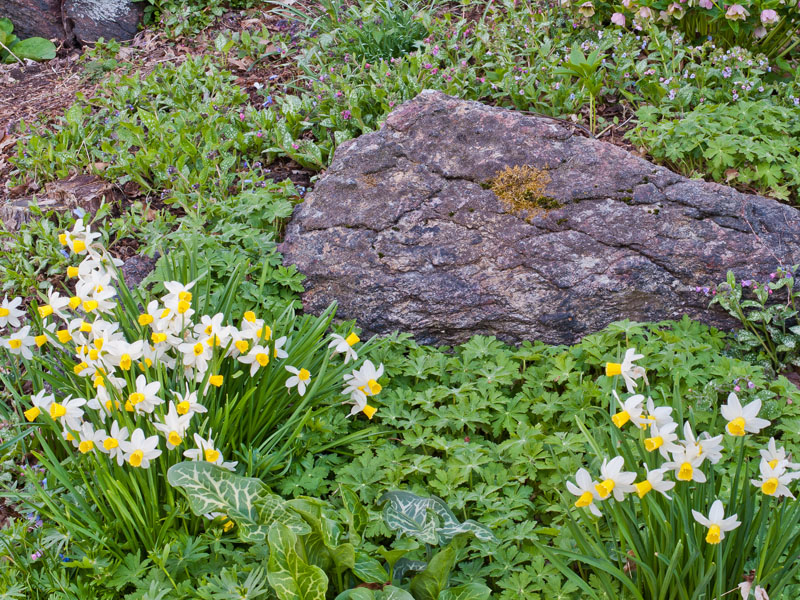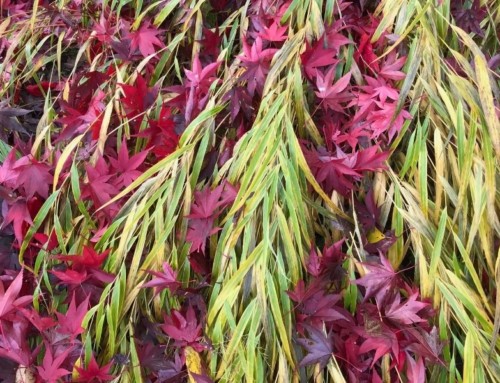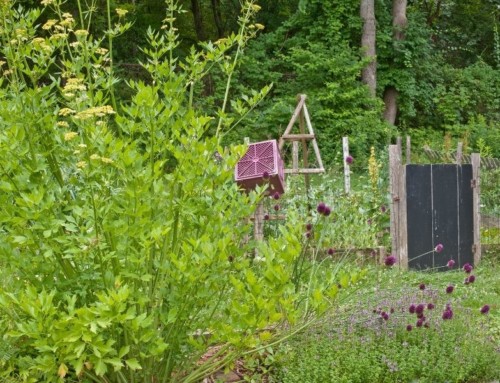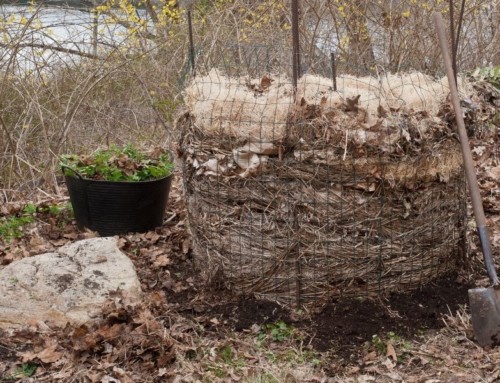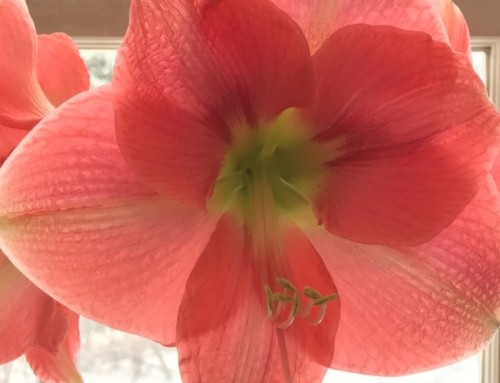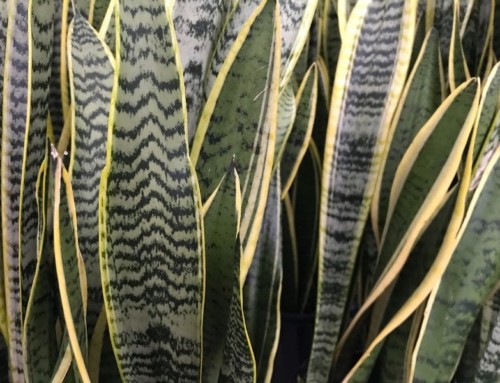As a garden coaching client and I were doing a strolling review in her garden, she gave me some valuable newsletter feedback.
She said she’d find it useful to learn all about one recommended plant at a time: What’s so good about it, how to recognize it in spring, where it grows, how to use and maintain, etc.
Then, as we walked past a mess of tall unruly ripening daffodil foliage, she remarked that it was time to braid the leaves to tidy things up.
STOP! Leave the leaves alone!
Do not knot, braid, tie, wrap with rubber bands, bend the leaves or cut them down. It’s not just a time-consuming chore at a busy time of year, it’s detrimental to the health of the plant. You can scratch it right off your to-do list.
Bulbs are perennials. Leaves need 8-10 weeks to produce food for next year’s growth and flowering, before turning yellow and going dormant.
Bunching suffocates the leaves, damages the vascular system and cuts off sunlight, starving the bulb. It’s ok to deadhead spent blooms, but leave stems, they photosynthesize too.
Yes, I know, it’s not a pretty picture.
To better integrate daffodils (and other bulbs) into the garden, seek out simpatico companions that support and conceal ripening bulb foliage without smothering it. May and early June are good times to look around the garden for plants that are the right size and habit at the right time.
Here’s my opportunity to answer both needs with one great plant that happens to be a perfect daffodil companion.
My Favorite Daffodil Companion
BIGROOT GERANIUM (GERANIUM MACRORRHIZUM)
Not being native isn’t something I’d hold against this cranesbill (it’s a European immigrant), because it is such a great problem-solving plant.
Bigroot geraniums are reliable, good-looking pretty much year-round and as close to zero-maintenance as you can get. (They hit that goal in my garden). They sprawl, but always in a neat-looking fashion.
I prefer magenta-flowering ‘Bevan’s Variety’ for its vigor and vibrant magenta flowers. ‘Ingwersen’s’ is a soft pink and ‘Alba’ is beautifully pristine, but less vigorous.
Bigroot geraniums have fat rhizomes near the surface of the ground. They spread quickly around rocks and other plants, forming a weed-suppressing ground cover. In moderately decent soil they thrive in dry shade (even under greedy, shallow-rooted maple trees) or sun, and are quite heat and drought-tolerant.
If they go where you don’t want them, just grab a handful, wiggle them out and stick them in the ground somewhere else, they won’t skip a beat.
Bigroot geraniums have attractive, toothed, 7-lobed palmate leaves that are slightly fuzzy and intensely fragrant. I rather enjoy the pungency, even though they make me sneeze when we’re in the car together. Deer and other herbivores do not seem to enjoy the smell or the fuzz one little bit.
GROWING GERANIUM MACRORRHIZUM WITH BULBS
One of bigroot geranium’s many assets is that they often retain a presence in the winter. Plants remain green well past early frosts. Gradually, some leaves flush red, some remain green, some shrivel up and drop off, and the plants flatten out.
In early spring, small bulbs like snowdrops easily push up through remaining foliage. The first flush of new green leaves is just tall enough to conceal fast-ripening snowdrop foliage.
As bigroot geraniums grow taller with rising spring temperatures, they provide a backdrop for daffodils – much prettier than muddy mulch or bare earth. Because they’re shallow-rooted, they don’t compete with bulbs below.
With daffodils, the bigger they are, the uglier they get post-bloom. That’s why I like short-to-medium-sized cultivars like ‘Hawera’, ‘Jetfire’ and ‘Jack Snipe’ (in photo above, with Geranium macrorrhizum).
They strut their stuff and melt away into perennials that follow (See bottom photo for post-daffodil bloom scenario). Since it’s no longer an eyesore, you can scratch removing ripe foliage off your to-do list too. Just let it decompose in place.
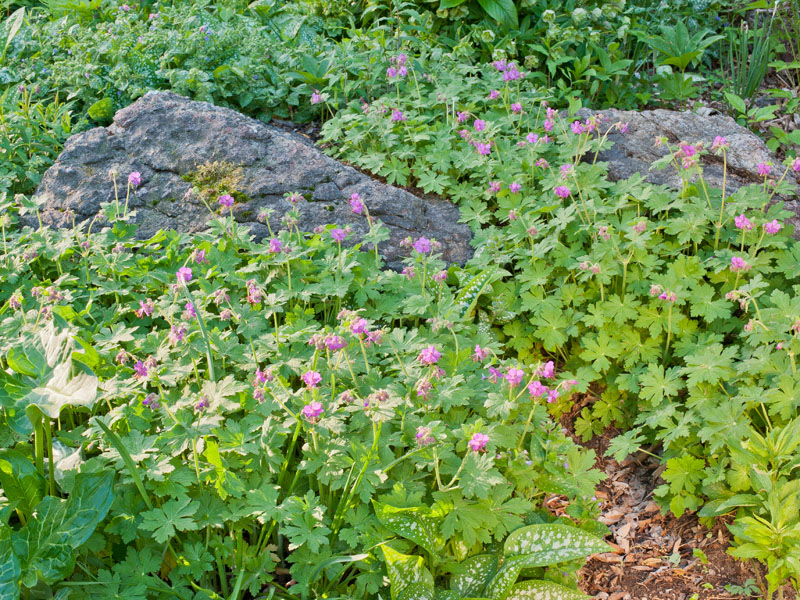
Geranium macrorrhizum ‘Bevans Variety’ blooms after daffodils and hides ripening bulb foliage.
Showy large cup daffodils like those in my client’s garden can top 16-18″. They’re harder to hide. Bigroot geraniums only grow to 12,” so we needed something taller.
Scoping out the garden for a plant strong enough to support daffodil leaves, yet open enough to let light in, I realized I had a pot of native golden Alexanders (Zizia aurea) in my hand. We had been looking for a place to put it.
It’s not necessarily the size it would become in the garden, or on the same time schedule, but it seemed about right, worth a try. We’ll find out next spring, after those glorious large-cup daffodils bloom.
